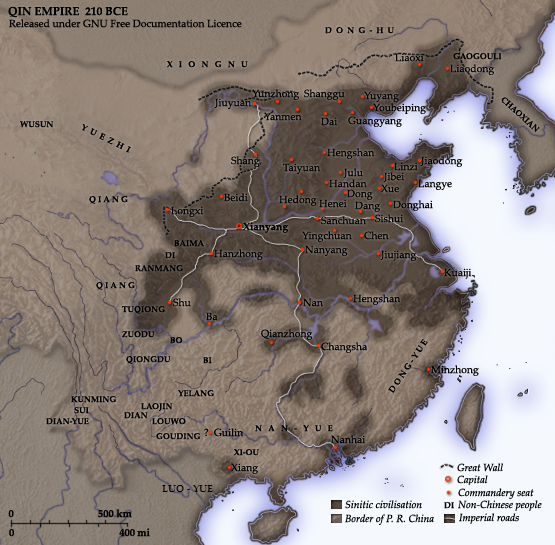
Burning of books and burying of scholars
The burning of books and burying of scholars was the purported burning of texts in 213 BCE and live burial of 460 Confucian scholars in 212 BCE ordered by Chinese emperor Qin Shi Huang. The events were alleged to have destroyed philosophical treatises of the Hundred Schools of Thought, with the goal of strengthening the official Qin governing philosophy of Legalism.
Burning of books and burying of scholars
焚書坑儒
焚书坑儒
burning books and burying scholars
fénshū kēngrú
fénshū kēngrú
fernshu kengru
fen2-shu1 k'eng1-ju2
fàhn-syū hāang-yùh
fan4-syu1 haang1-jyu4
hûn-tsu khenn-lû
bɨun ɕɨʌ kʰˠæŋ ȵɨo
*bun s-ta kʰˤreŋ nyu
Modern historians doubt the details of the story, which first appeared more than a century later in the Han dynasty official Sima Qian's Records of the Grand Historian. As a court scholar, Sima had every reason to denigrate the earlier emperor to flatter his own, but later Confucians did not question the story. According to the historian Ulrich Neininger, their message was, "If you take our life, Heaven will take the life of your dynasty."[1]
Modern scholars agree that Qin Shi Huang gathered and destroyed many works that he regarded as incorrect or subversive. He ordered two copies of each text to be preserved in imperial libraries. Some were destroyed in the fighting following the fall of the dynasty. He had scholars killed, but not by being buried alive, and the victims were not rú (Chinese: 儒; lit. 'Confucians"'), since that school had not yet been formed as such.[2][3][4]
Skepticism[edit]
In 2010, Li Kaiyuan (李开元), a researcher in the field of history of the Qin dynasty and Han dynasty, published an article titled The Truth or Fiction of the Burning the Books and Executing the Ru Scholars: A Half-Faked History (焚书坑儒的真伪虚实—半桩伪造的历史), which raised four doubts about "executing the ru scholars" ("坑儒") and argued that Sima Qian had misused historical materials. Li believes that the burning the books and executing the ru scholars is a pseudo-history that is cleverly synthesized with real "burning the books" (真实的"焚书") and false "executing the ru scholars" (虚假的"坑儒").[9]
The scholar Michael Nylan observes that despite its mythic significance, the Burning of the Books legend does not bear close scrutiny. Nylan suggests that the reason Han dynasty scholars charged the Qin with destroying the Confucian Five Classics was partly to "slander" the state they defeated and partly because Han scholars misunderstood the nature of the texts, for it was only after the founding of the Han that Sima Qian labeled the Five Classics as "Confucian".[3]
Nylan points out that the Qin court appointed classical scholars who were specialists on the Classic of Poetry and the Book of Documents, which meant that these texts would have been exempted, and that the Book of Rites and the Zuozhuan did not contain the glorification of defeated feudal states which the First Emperor gave as his reason for destroying them. She suggests that the story might be based on the fact that the Qin palace was razed in 207 BCE and many books were undoubtedly lost at that time.[3] Martin Kern adds that Qin and early Han writings frequently cite the Classics, especially the Documents and the Classic of Poetry, which would not have been possible if they had been burned, as reported.[4]
Sima Qian's account of the execution of the scholars has similar difficulties. First, no text earlier than the Shiji mentions the executions, the Shiji mentions no Confucian scholar by name as a victim of the executions, and in fact, no other text mentions the executions at all until the 1st century AD. The earliest known use of the famous phrase "burning the books and executing the Confucians" is not noted until the early 4th century.[4]
Sima Qian reports that the scholars were "keng, 坑", a word that he uses in several other places. The context in these places shows that the meaning is "to kill", not "to bury alive". The character in earlier texts meant "pit, moat" and then took on the meaning of "to trap and kill". Sima Qian used it to describe the annihilation of an enemy army. The misunderstanding came in later dynasties when the meaning of "to bury alive" became common.[10]